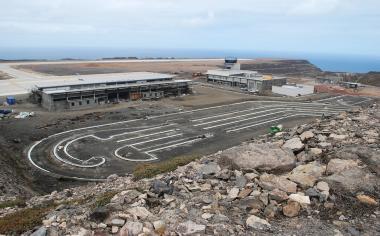Basil Read sure it is blameless over St Helena
 Basil Read continues to be buffeted by the R4.6bn St Helena Airport it is building on behalf of the British government.
Basil Read continues to be buffeted by the R4.6bn St Helena Airport it is building on behalf of the British government.
Basil Read continues to be buffeted by the R4.6bn St Helena Airport it is building on behalf of the British government, despite the UK department for international development confirming there are no legal claims around wind-related project delays.
The JSE-listed construction and engineering group has a 10-year contract to operate the airport.
The company says it is not to blame for the design debacle, which has seen wind shear and turbulence prevent commercial flights from landing on the remote south Atlantic island, despite the opening of the airport to traffic. But the British media has been having a field day over the saga, made more spicy as a post-Brexit government struggles to keep the issue at the top of its agenda.
Funded by the department for international development, it has been a millstone around the necks of project participants, including Comair. The South African airline is contracted to service the island with a 10 hour return flight from Johannesburg once a week. But these have not begun because of safety concerns.
ALSO READ: Black women-owned company to buy majority stake in Aveng
Basil Read says, however, that the airport has allowed for a number of medical air evacuations that were previously not possible. The island is home to about 4,000 permanent inhabitants. Until recently, it could be reached by sea only.
A representative of the department said there are no legal claims relating to the wind shear problem.
Basil Read says that after more than four years of construction, the aerodrome certificate was issued on May 10 by regulator Air Safety Support International, a subsidiary of the UK Civil Aviation Authority.
In reporting its six-month results to June, Basil Read also says that liquidity remains tight, especially in the construction division, and that cash outflows are largely due to working capital changes, as advance payments received on the St Helena airport project are being unwound as the contract nears completion.
“No, Basil Read is not to blame [for the wind shear problems],” says Jimmy Johnston, executive officer responsible for the St Helena airport project. “The airport has been fully operational since the aerodrome certificate was issued, with various charter flights landing on a regular basis.”
He says: “Wind shear affects all aircraft to a greater or lesser degree, subject to weather conditions, but if the wind conditions are good, then there is no wind shear.”
The development of the airport was approved in 2010 by the then UK development secretary Andrew Mitchell, according to The Guardian newspaper.
The cliff-top landing strip was part of a plan to end the island’s dependency on UK government subsidies. The RMS St Helena, which carries tourists and locals on a five-day journey between the island and Cape Town, is due to be retired but will continue for the time being.
The scope of construction work for the airport caters for aircraft up to the size of an Airbus A320 and Boeing 737800, an airport terminal building of 3,500m² and a bulk fuel installation for 6-million litres, along with a 14km airport access road. Phase two work will run to 2026.
The department’s representative says that UK Secretary of State for International Development Priti Patel has appointed an external expert to review the evidence. The department will establish a panel to find a solution.
The representative also says steps are being taken to tackle turbulence and wind shear, which are “notoriously difficult to predict in advance”.
“All the parties are committed to work intensively to find a solution, and getting it right will take some time,” the representative says.
“While delays are always frustrating, safety is our paramount concern and we will not commence commercial flights until we are satisfied with every aspect of airport operations.”
Stuart Cochrane, Comair executive manager of business processes, says Comair is not directly involved in gathering weather information at St Helena airport, but an implementation flight was conducted to ensure the airline would be able to offer a safe, reliable air service.
Data from this flight indicates that more work needs to be done to mitigate turbulence and wind shear on the approach. “We remain willing to work with all stakeholders to provide an air service to the island,” Cochrane says.
















